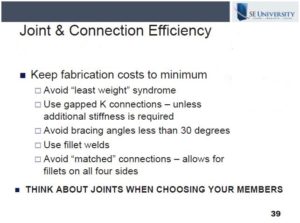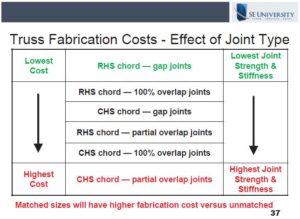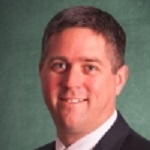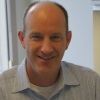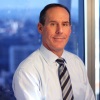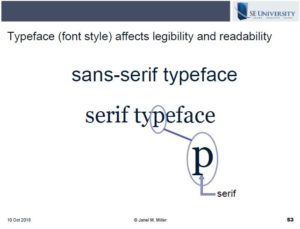13 Mar 2019
Resources for Truss Connection Design
Typically, engineers rely heavily on Chapter K of AISC 360 for design guidance for HSS connection designs. However, there are many additional resources available including additional design examples and principles which are not referenced or included in AISC 360.
In the January 2019 SE University session, Brad Fletcher, SE, from Atlas Tube, gave a presentation on HSS Truss Connections: The Ts, Ks, and Ys of It All. Brad reviewed ways that HSS truss joint configurations affects the strength and stiffness of the overall truss, as well as how the fabrications costs of the truss relate to the truss joints connections and details.
Brad offered several resources for the design of steel trusses, connections, and multi-planar trusses. Of course, AISC 360 offers design guidance in Chapter K for HSS connections, however AISC Design Guide 24 adds further insight for HSS connection design. Brad noted this design guide will be enhanced and released again later this year.
CIDECT (International Committee for the Development and Study of Tubular Structures) also offers great examples and principles which may not be covered in the AISC design guides. The 9 CIDECT design guides are available for free download on the AISC website, and further support can be found directly from CIDECT.
Steel Tube Institute also offers several online tools as well as HSS Design Manuals. These online tools include spreadsheets as well as HSS CONNEX which code checks your joint configuration. Some items are available for free to members while others may be purchased without membership.
Having and using these additional resources can give an engineers more insight into the intricacies of HSS joints and connection design which can help to increase truss strength and stiffness while minimizing fabrication costs. Online tools are especially helpful to code check individual connections and save valuable design time on your next project.
25 Feb 2019
Efficient HSS Truss Connection Design
When designing trusses, do you often include joint connections in the main design, or is it more an afterthought once the main structural members are selected based on strength? Often times, engineers will focus on minimizing the weight of the truss members, without regard to the joint design details, and this can prove to be a costly error.
In the January 2019 SE University session, Brad Fletcher, SE, from Atlas Tube, gave a presentation on HSS Truss Connections: The Ts, Ks, and Ys of It All. Brad reviewed ways that HSS truss joint configurations affects the strength and stiffness of the overall truss, as well as how the fabrications costs of the truss relate to the truss joints rather than simply the overall weight of the truss.
Brad highlighted some important rules of thumb which can be used to design efficient trusses. As a general rule, Brad suggested aiming to design chord members to be relatively stocky (low D/t or B/t) while branch members should have a larger diameter, but thinner walls (high D/t or B/t). Using this recommendation, you can avoid “thick to thin” welding and an added benefit of less surface area at the chord to reduce painting costs.
Brad also offered some additional pointers to keep fabrication costs low, as shown in the slide below. As he points out, engineers often focus only on reducing the steel tonnage of their trusses, however, there are many ways to design a less costly truss by considering the joints specifically when designing the overall truss.
When a more costly truss connection is necessary to improve strength or stiffness values, Brad offered the following step-wise approach to consider costs while improving strength. As you can see in the slide, using Rectangular Hollow Section chords with gap joints have the lowest costs and lowest strength and stiffness values, while Circular Hollow Section chords with partial overlap joints have the highest costs and highest strength and stiffness values.
Taking steps to avoid costly Complete Joint Penetration welds and overlapped joints can often save more than solely minimizing the overall chord and web member sizes. These guidelines presented are a great starting point to begin an efficient design which considers the effect of joint configuration on the cost of the truss.
25 Feb 2019
Improvements to ASCE 7-16 Wind Maps
Are you familiar with the changes to the wind provisions in ASCE 7-16? If you’ve taken the time to look at the wind maps, you may have noticed some significant changes to the contours and wind speed, but there are other changes that will affect your daily designs within the wind provisions. It is important to not only know what has changed, but why the changes were made.
In November 2018, Don Scott, SE, from PCS Structural Solutions, presented ASCE 7-16 Wind Provisions – Changes Affecting the Design Provisions. Don covered the changes to the new wind speed maps and explained how to determine the design wind speed. He also presented the changes to the roof pressure coefficients, and explained the effects of the new Elevation Factor.
Don was able to provide much insight as to what went into the changes to the wind speed maps and roof pressure coefficients. Since ASCE had not made changes to the non-hurricane wind speeds since 7-95, there was a significant increase in new anemometer locations and data gained from these locations. The new maps now reflect more regional variability in extreme wind climates. Wind speeds in the great plains remain unchanged, but for the rest of the country wind speeds have decreased, most significantly along the west coast. Also, new hurricane models have reduced the hurricane winds along the northeast coast, while the hurricane winds along the southeast coastlines remain unchanged.
Don offered two permitted web based tools that may be used to access wind speed data for various locations in the United States. The first option is the Applied Technology Council’s (ATC) WINDSPEED BY LOCATION website which available free of charge. The second option is ASCE 7 HAZARD TOOL which is available to registered members. This tool provides all design parameters specified by ASCE 7-16 for a given site.
While most of the country will appreciate some wind pressure reductions, there will be more regional variability nationwide than in previous editions of ASCE7 due to the new wind map contours. Overall, the new improvements made to the ASCE 7-16 wind provisions will result in more accurate reflections of the wind speeds being witnessed at various anemometer locations throughout the United States.
In February 2019, SE University welcomed back Matthew Rechtien, PE, Esq., Senior Assistant City Attorney with the City of Ann Arbor, to present Engineering Ethics Update and Miscellany. In 2017 and 2018, he designated the David and Maxine Fowler Endowed Excellence Fund at the University of Texas at Austin (http://www.caee.utexas.edu/alumni/gift/opportunites) for the SEU Speaker Inspires donation of the month, and he has chosen to do the same in 2019.
Matthew previously shared why he chose the David and Maxine Fowler Endowed Excellence Fund: “Dr. Fowler, with the support of his wife, Maxine, has been a mentor, advocate, and friend for twenty years. As a professor at the University of Texas for half a century, he has touched the lives of literally hundreds of other engineering students, engineers and others in a similar way. Dr. Fowler is a gentleman and scholar in every sense of those words. I am humbled to be able to contribute, in any way (but especially by, as he did, teaching my fellow engineers), to his legacy, including the David and Maxine Fowler Endowed Excellence Fund.”
Thank you, Matthew, for helping structural engineers with your SE University session, and for your designation of the David and Maxine Fowler Endowed Excellence Fund as our SEU Speaker Inspires Organization of the Month!
SE University began the SEU Speaker Inspires program in 2015 as a way to “pay it forward”, enabling our speakers to designate a charity/organization of their choice for SE University to make a donation to help improve our world.
In January 2019, SE University welcomed Brad Fletcher, SE, from Atlas Tube, to present HSS Truss Connections: The Ts, Ks, and Ys of It All. Brad designated the Alzheimer’s Association (https://www.alz.org/) for the SEU Speaker Inspires donation of the month.
Brad shared that he chose this organization because “My Dad had Alzheimer’s and my mom had dementia so I have firsthand knowledge on how challenging it can be.”
According to its website, “The Alzheimer’s Association is the leading voluntary health organization in Alzheimer’s care, support and research. Our mission is to eliminate Alzheimer’s disease through the advancement of research; to provide and enhance care and support for all affected; and to reduce the risk of dementia through the promotion of brain health.”
Thank you, Brad, for helping structural engineers with your SE University session, and for your designation of the the Alzheimer’s Association as our SEU Speaker Inspires Organization of the Month!
SE University began the SEU Speaker Inspires program in 2015 as a way to “pay it forward”, enabling our speakers to designate a charity/organization of their choice for SE University to make a donation to help improve our world.
28 Jan 2019
Accurate Timekeeping
How often have you procrastinated tracking your billable time until the end of the day only to forget the exact time spent with each project? Accurately billing your time is not only important to your employer, but can also be an ethical issue for the client. Keeping good records of your time throughout the day is the best way to help your employer determine which projects are successful financially and which projects might be at risk to lose money.
Constant vigilance is the best approach to record keeping. No doubt most employers require some type of automated timekeeping system, however, using these systems throughout the day may prove too labor intensive to be efficient. One way to begin the process of accurately tracking your time may be to keep a journal to quickly write in tasks as they appear throughout the day. This will be separate from any electronic calendar you may use, as tasks often crop up that are not pre-planned but may require immediate attention. Quickly jot down each task and time spent at natural transitions throughout the day such as at the end of a phone call or the completion of a meeting. Journals are also convenient to take with you when leaving the office for visits to the job site and are useful to jot down mileage as well as travel time. At the end of the day, you can access your automated timekeeping system to enter each project’s billable time. Be consistent, and your new record keeping habit will become second nature.
Be on the lookout for tasks that typically go overlooked such as writing emails, client phone calls, or overrun meetings. Since these items tend to be more unexpected, it is often hard to track the exact time spent, however, being vigilant at the end of each task will more accurately capture how much time is truly spent on these small, but significant tasks. Every employer will appreciate this extra effort made to accurately recount your billable activity.
In December 2018, SE University welcomed John Hooper, PE, SE, from Magnusson Klemencic Associates, to present Updates to the Seismic Provisions in ASCE 7-16. John designated the Providence General Foundation in Everett, Washington (https://washington.providence.org/donate/providence-general-foundation) for the SEU Speaker Inspires donation of the month.
John shared that he chose this organization because “It’s a healthcare-related foundation I’ve been involved with for nearly 20 years. The healthcare they provide the region is unparalleled as I experienced firsthand when my son was born 6 weeks prematurely in 1999.”
The Providence General Foundation was established in 1994 to help support the mission and work of Providence Regional Medical Center Everett. The Foundation raises funds on behalf of Providence Regional to help ensure that all individuals in the Northern Puget Sound Region have access to the most compassionate and advanced health care available, regardless of their ability to pay. This work is only possible through the support of employees, physicians, community leaders, volunteers, and generous donors—who give so freely of their time, treasure, and talent to help further the mission of Providence in our region.
Thank you, John, for helping structural engineers with your SE University session, and for your designation of the Providence General Foundation as our SEU Speaker Inspires Organization of the Month!
SE University began the SEU Speaker Inspires program in 2015 as a way to “pay it forward”, enabling our speakers to designate a charity/organization of their choice for SE University to make a donation to help improve our world.
In November 2018, SE University welcomed Don Scott, SE, from PCS Structural Solutions, to present ASCE 7-16 Wind Provisions – Changes Affecting the Design Provisions. Don designated the SEI Futures Fund (https://www.ascefoundation.org/ways-to-give/sei-futures-fund/) for the SEU Speaker Inspires donation of the month.
Don chose this organization because, “The resources of this fund are used to promote the many needs of the Structural Engineering profession and in particular to provide resources for young engineers entering the profession to become involved.”
Thank you, Don, for helping structural engineers with your SE University session, and for your designation of the SEI Futures Fund as our SEU Speaker Inspires Organization of the Month!
SE University began the SEU Speaker Inspires program in 2015 as a way to “pay it forward”, enabling our speakers to designate a charity/organization of their choice for SE University to make a donation to help improve our world.
In September 2018, SE University welcomed Donald Meinheit, PhD, PE, SE, from Wiss, Janney, Elstner Associates, Inc., to present Anchors: Design Examples and Qualification/Certification/Inspection. Don has chosen to split his donation between the foundations for ASCE (https://www.ascefoundation.org/), ACI (https://www.acifoundation.org/), PCI (http://pci-foundation.org/), and CRSI (http://crsi-foundation.org/) for the SEU Speaker Inspires donation of the month.
Don shared why he chose these professional organizations: “When in school, whether undergraduate or graduate, knowing how your career will unfold is impossible to imagine. I was recently given the opportunity to discuss a topic that many years ago was not on any radar, but now is an interesting and important design aspect for connecting structural elements together. I credit the ability to learn new things to both the universities I attended and the professional organizations in which I have taken an active role. That is why in addition to the three universities named last month, I have elected to donate the honorarium to the following professional organizations: American Society of Civil Engineers (ASCE), American Concrete Institute (ACI), Prestressed Concrete Institute (PCI), and the Concrete Reinforcing Steel Institute (CRSI) foundations.”
Thank you, Don, for helping structural engineers with your SE University session, and for your designation of the foundations for American Society of Civil Engineers (ASCE), American Concrete Institute (ACI), Prestressed Concrete Institute (PCI), and the Concrete Reinforcing Steel Institute (CRSI) foundations as our SEU Speaker Inspires Organizations of the Month!
SE University began the SEU Speaker Inspires program in 2015 as a way to “pay it forward”, enabling our speakers to designate a charity/organization of their choice for SE University to make a donation to help improve our world.
15 Nov 2018
Font Styles in Technical Writing
Have you considered when and where to use certain font styles in your daily technical documents? Are font styles purely decorative in nature, or do they serve a more meaningful purpose? Which fonts are appropriate for technical writings?
In October 2018, Janel Miller, from the University of Wisconsin at Madison, gave a presentation on Improving Clarity, Coherence, and Conciseness in Technical Writing. Janel reviewed how to prepare coherent documents, engage and persuade readers, and apply principles of concise writing to improve clarity.
Janel also discussed the use of different typeface or font styles which can affect readability and legibility. Janel included the following slide showing the difference between serif and sans-serif fonts.
As you can see, the serif font includes small, decorative flourishes (called serifs) at the ends of the strokes, whereas the sans-serif (or without-serif) typeface does not. These small serifs may seem insignificant, but they actually serve a purpose for serif fonts such as Times or Georgia. Serifs help the reader follow lines of text when reading large blocks of text in print or reports. In contrast, sans-serif fonts, such as Helvetica and Calibri, are easier to read at a distance or on small screens and mobile devices. Sans-serif fonts are recommended for wayfinding signs on roads, presentations in PowerPoint, and text in emails especially when read on mobile devices.
Your font style selection may affect the ability of the audience to read the document accurately and quickly. Be sure to consider whether a serif or sans-serif font would be most applicable in your future technical reports, emails, or on-screen presentations in order to visually assist your audience in reading your technical content.

